Simulation of Multi-Scale Water Supply Service Flow Pathways and Ecological Compensation for Urban–Rural Sustainability: A Case Study of the Fenhe River Basin
Abstract
1. Introduction
2. Materials and Methods
2.1. Study Area Overview
2.2. Data
2.3. Methods Applied
2.3.1. Ecosystem Service Supply Assessment
2.3.2. Ecosystem Service Demand Assessment
2.3.3. Ecosystem Service Supply and Demand Matching
2.3.4. Ecosystem Service Flow Network Construction
Water Ecosystem Service Flow Network Construction
County-Level Analysis
2.3.5. Ecological Compensation Policy
3. Results
3.1. Supply and Demand of Water Ecosystem Services
3.2. The Matching Relationship Between Supply and Demand of Water Ecosystem Services
3.3. Simulation of Water Ecosystem Service Flows
3.3.1. At the Sub-Basin Scale
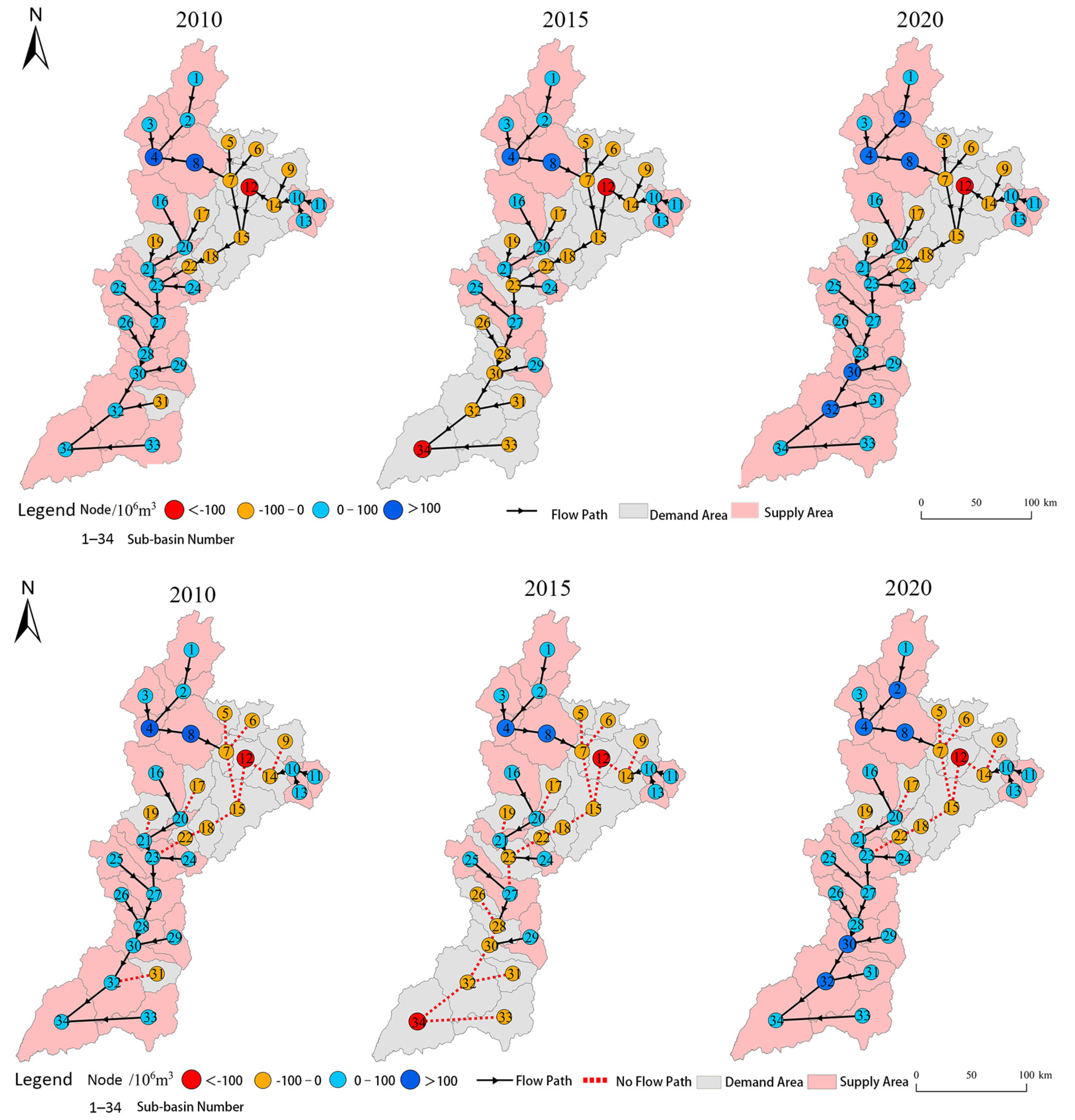
3.3.2. At the County-Level
3.4. Allocation Ratios of Ecological Compensation Funds
3.4.1. At the Sub-Basin Scale
3.4.2. At the County-Level Scale
3.5. Calculation and Revision of Ecological Compensation Amounts for Water Ecosystem Services
4. Discussion
4.1. Characteristics of Water Ecosystem Service Flows in the Fenhe River Basin
4.2. Rationality and Necessity of Using Ecosystem Service Flows for Ecological Compensation
4.3. Spatial Scale Challenges in Compensation Design
4.4. Research Limitations and Advances
5. Conclusions
Supplementary Materials
Author Contributions
Funding
Data Availability Statement
Conflicts of Interest
References
- Lyu, R.; Zhang, J.; Xu, M.; Li, J. Impacts of urbanization on ecosystem services and their temporal relations: A case study in Northern Ningxia, China. Land Use Policy 2018, 77, 163–173. [Google Scholar] [CrossRef]
- Liu, H.; Xiao, W.; Zhu, J.; Zeng, L.; Li, Q. Urbanization intensifies the mismatch between the supply and demand of regional ecosystem services: A large-scale case of the Yangtze River Economic Belt in China. Remote Sens. 2022, 14, 5147. [Google Scholar] [CrossRef]
- Li, P.; Liu, C.; Liu, L.; Wang, W. Dynamic analysis of supply and demand coupling of ecosystem services in Loess Hilly Region: A case study of Lanzhou, China. Chin. Geogr. Sci. 2021, 31, 276–296. [Google Scholar]
- Peng, S.; Ding, Y.; Wen, Z.; Chen, Y.; Cao, Y.; Ren, J. Spatiotemporal change and trend analysis of potential evapotranspiration over the Loess Plateau of China during 2011–2100. Agric. For. Meteorol. 2017, 233, 183–194. [Google Scholar]
- Pinto, R.; de Jonge, V.N.; Marques, J.C. Linking biodiversity indicators, ecosystem functioning, provision of services and human well-being in estuarine systems: Application of a conceptual framework. Ecol. Indic. 2014, 36, 644–655. [Google Scholar]
- Haines-Young, R.; Potschin, M. The links between biodiversity, ecosystem services and human well-being. Ecosyst. Ecol. A New Synth. 2010, 1, 110–139. [Google Scholar]
- Hernández-Blanco, M.; Costanza, R.; Chen, H.; DeGroot, D.; Jarvis, D.; Kubiszewski, I.; Montoya, J.; Sangha, K.; Stoeckl, N.; Turner, K. Ecosystem health, ecosystem services, and the well-being of humans and the rest of nature. Glob. Change Biol. 2022, 28, 5027–5040. [Google Scholar]
- Costanza, R. Ecosystem services: Multiple classification systems are needed. Biol. Conserv. 2008, 141, 350–352. [Google Scholar]
- Serna-Chavez, H.; Schulp, C.; Van Bodegom, P.; Bouten, W.; Verburg, P.; Davidson, M. A quantitative framework for assessing spatial flows of ecosystem services. Ecol. Indic. 2014, 39, 24–33. [Google Scholar]
- Bagstad, K.J.; Villa, F.; Batker, D.; Harrison-Cox, J.; Voigt, B.; Johnson, G.W. From theoretical to actual ecosystem services: Mapping beneficiaries and spatial flows in ecosystem service assessments. Ecol. Soc. 2014, 19, 64. [Google Scholar] [CrossRef]
- Fisher, B.; Turner, R.K.; Morling, P. Defining and classifying ecosystem services for decision making. Ecol. Econ. 2009, 68, 643–653. [Google Scholar]
- Jones, L.; Norton, L.; Austin, Z.; Browne, A.; Donovan, D.; Emmett, B.; Grabowski, Z.; Howard, D.; Jones, J.P.; Kenter, J. Stocks and flows of natural and human-derived capital in ecosystem services. Land Use Policy 2016, 52, 151–162. [Google Scholar] [CrossRef]
- Villamagna, A.M.; Angermeier, P.L.; Bennett, E.M. Capacity, pressure, demand, and flow: A conceptual framework for analyzing ecosystem service provision and delivery. Ecol. Complex. 2013, 15, 114–121. [Google Scholar] [CrossRef]
- Schirpke, U.; Candiago, S.; Egarter Vigl, L.; Jäger, H.; Labadini, A.; Marsoner, T.; Meisch, C.; Tasser, E.; Tappeiner, U. Integrating supply, flow and demand to enhance the understanding of interactions among multiple ecosystem services. Sci. Total Environ. 2019, 651, 928–941. [Google Scholar] [CrossRef]
- Daily, G.C.; Polasky, S.; Goldstein, J.; Kareiva, P.M.; Mooney, H.A.; Pejchar, L.; Ricketts, T.H.; Salzman, J.; Shallenberger, R. Ecosystem services in decision making: Time to deliver. Front. Ecol. Environ. 2009, 7, 21–28. [Google Scholar] [CrossRef]
- Bagstad, K.J.; Johnson, G.W.; Voigt, B.; Villa, F. Spatial dynamics of ecosystem service flows: A comprehensive approach to quantifying actual services. Ecosyst. Serv. 2013, 4, 117–125. [Google Scholar] [CrossRef]
- Baró, F.; Palomo, I.; Zulian, G.; Vizcaino, P.; Haase, D.; Gómez-Baggethun, E. Mapping ecosystem service capacity, flow and demand for landscape and urban planning: A case study in the Barcelona metropolitan region. Land Use Policy 2016, 57, 405–417. [Google Scholar] [CrossRef]
- Anton, C.; Young, J.; Harrison, P.A.; Musche, M.; Bela, G.; Feld, C.K.; Harrington, R.; Haslett, J.R.; Pataki, G.; Rounsevell, M.D. Research needs for incorporating the ecosystem service approach into EU biodiversity conservation policy. Biodivers. Conserv. 2010, 19, 2979–2994. [Google Scholar] [CrossRef]
- Li, X.; Li, X.; Lyu, X.; Dang, D.; Wang, K.; Zhang, C.; Cao, W. Linking ecological and social systems to promote regional security management: A perspective of ecosystem services supply-flow-demand. Ecol. Indic. 2023, 156, 111124. [Google Scholar] [CrossRef]
- Yuan, C.; Weng, Y.; Xiong, K.; Rong, L. Projections of Land Use Change and Water Supply–Demand Assessment Based on Climate Change and Socioeconomic Scenarios: A Case Study of Guizhou Province, China. Land 2024, 13, 194. [Google Scholar] [CrossRef]
- Shang, W.; Gong, Y.; Wang, Z.; Stewardson, M.J. Eco-compensation in China: Theory, practices and suggestions for the future. J. Environ. Manag. 2018, 210, 162–170. [Google Scholar]
- Zhang, X.; Li, F.; Li, X. Bibliometric analysis of ecological compensation and its application in land resources. Landsc. Ecol. Eng. 2021, 17, 527–540. [Google Scholar] [CrossRef]
- Adhikari, R.K.; Kindu, M.; Pokharel, R.; Castro, L.M.; Knoke, T. Financial compensation for biodiversity conservation in Ba Be National Park of Northern Vietnam. J. Nat. Conserv. 2017, 35, 92–100. [Google Scholar] [CrossRef]
- Zheng, X.; Zhang, J.; Cao, S. Net value of grassland ecosystem services in mainland China. Land Use Policy 2018, 79, 94–101. [Google Scholar]
- Eskandari-Damaneh, H.; Noroozi, H.; Ghoochani, O.M.; Taheri-Reykandeh, E.; Cotton, M. Evaluating rural participation in wetland management: A contingent valuation analysis of the set-aside policy in Iran. Sci. Total Environ. 2020, 747, 141127. [Google Scholar]
- Iranah, P.; Lal, P.; Wolde, B.T.; Burli, P. Valuing visitor access to forested areas and exploring willingness to pay for forest conservation and restoration finance: The case of small island developing state of Mauritius. J. Environ. Manag. 2018, 223, 868–877. [Google Scholar]
- Sheng, W.; Zhen, L.; Xie, G.; Xiao, Y. Determining eco-compensation standards based on the ecosystem services value of the mountain ecological forests in Beijing, China. Research on ecological compensation standard based on ecological service value of Beijing mountain ecological public welfare forest. Ecosyst. Serv. 2017, 26, 422–430. [Google Scholar] [CrossRef]
- Zhong, S.; Geng, Y.; Huang, B.; Zhu, Q.; Cui, X.; Wu, F. Quantitative assessment of eco-compensation standard from the perspective of ecosystem services: A case study of Erhai in China. J. Clean. Prod. 2020, 263, 121530. [Google Scholar] [CrossRef]
- Yang, Y.; Yao, C.; Xu, D. Ecological compensation standards of national scenic spots in western China: A case study of Taibai Mountain. Tour. Manag. 2020, 76, 103950. [Google Scholar] [CrossRef]
- Yang, Y.; Lu, H.; Liang, D.; Chen, Y.; Tian, P.; Xia, J.; Wang, H.; Lei, X. Ecological sustainability and its driving factor of urban agglomerations in the Yangtze River Economic Belt based on three-dimensional ecological footprint analysis. J. Clean. Prod. 2022, 330, 129802. [Google Scholar] [CrossRef]
- Zhang, C.; Li, J.; Zhou, Z.; Sun, Y. Application of ecosystem service flows model in water security assessment: A case study in Weihe River Basin, China. Ecol. Indic. 2021, 120, 106974. [Google Scholar] [CrossRef]
- Yu, Y.; Li, J.; Han, L.; Zhang, S. Research on ecological compensation based on the supply and demand of ecosystem services in the Qinling-Daba Mountains. Ecol. Indic. 2023, 154, 110687. [Google Scholar] [CrossRef]
- Engel, S.; Palmer, C.; Taschini, L.; Urech, S. Conservation payments under uncertainty. Land Econ. 2015, 91, 36–56. [Google Scholar] [CrossRef]
- Liu, Q.; Qiao, J.; Li, M.; Huang, M. Spatiotemporal heterogeneity of ecosystem service interactions and their drivers at different spatial scales in the Yellow River Basin. Sci. Total Environ. 2024, 908, 168486. [Google Scholar] [CrossRef]
- Yang, J.; Huang, X. 30 m annual land cover and its dynamics in China from 1990 to 2019. Earth Syst. Sci. Data Discuss. 2021, 2021, 1–29. [Google Scholar]
- Ding, Y.; Peng, S. Spatiotemporal change and attribution of potential evapotranspiration over China from 1901 to 2100. Theor. Appl. Climatol. 2021, 145, 79–94. [Google Scholar] [CrossRef]
- Wang, C.; Wang, J. Kilometer Grid Dataset of China’s Historical GDP Spatial Distribution (1990–2015); A Big Earth Data Platform for Three Poles; National Tibetan Plateau Data Center: Beijing, China, 2022. [Google Scholar]
- Wu, C.; Lu, R.; Zhang, P.; Dai, E. Multilevel ecological compensation policy design based on ecosystem service flow: A case study of carbon sequestration services in the Qinghai-Tibet Plateau. Sci. Total Environ. 2024, 921, 171093. [Google Scholar] [CrossRef] [PubMed]
- Thieme, M.L.; Tickner, D.; Grill, G.; Carvallo, J.P.; Goichot, M.; Hartmann, J.; Higgins, J.; Lehner, B.; Mulligan, M.; Nilsson, C. Navigating trade-offs between dams and river conservation. Glob. Sustain. 2021, 4, e17. [Google Scholar] [CrossRef]
- Tao, Y.; Tao, Q.; Qiu, J.; Pueppke, S.G.; Gao, G.; Ou, W. Integrating water quantity-and quality-related ecosystem services into water scarcity assessment: A multi-scenario analysis in the Taihu Basin of China. Appl. Geogr. 2023, 160, 103101. [Google Scholar] [CrossRef]
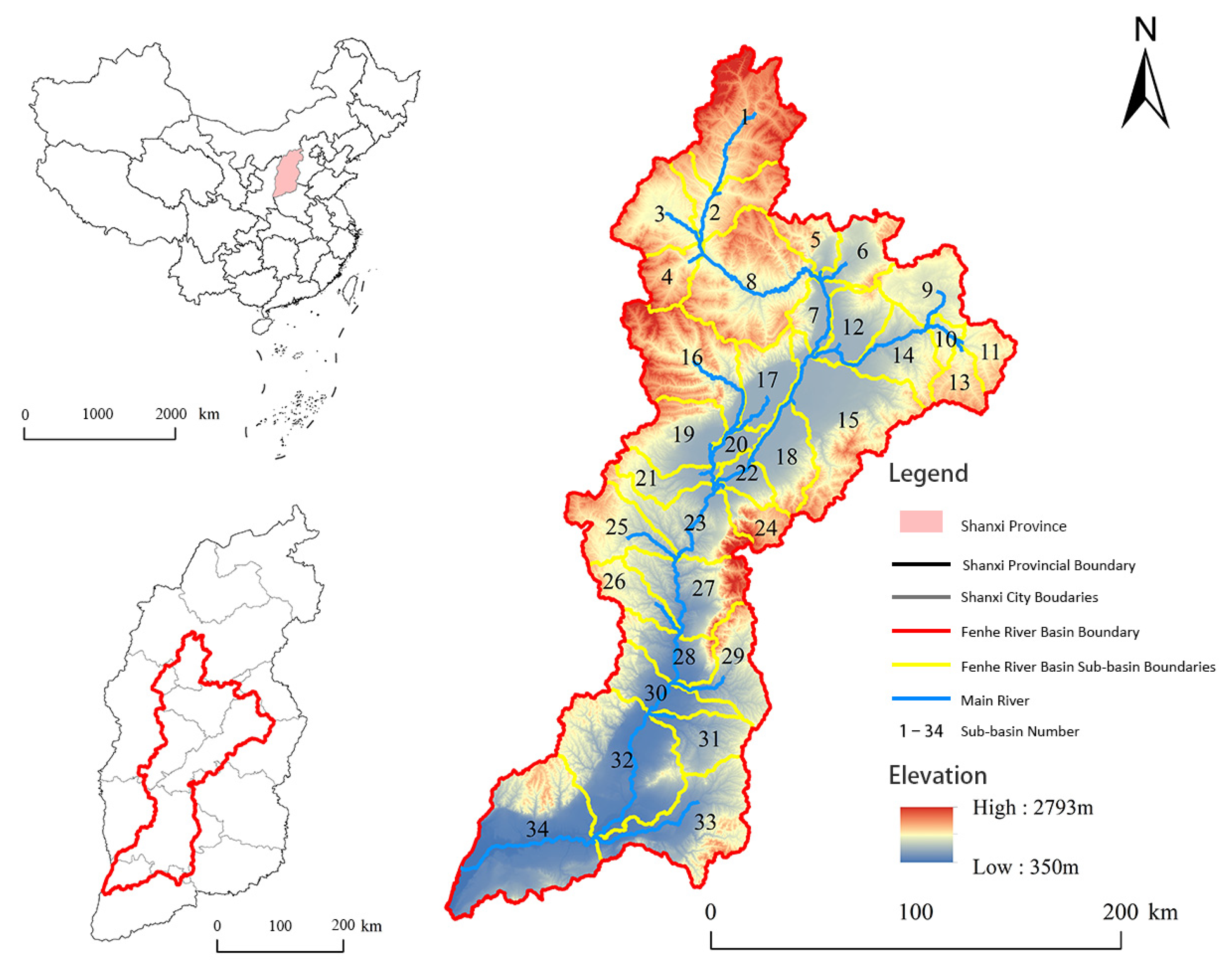
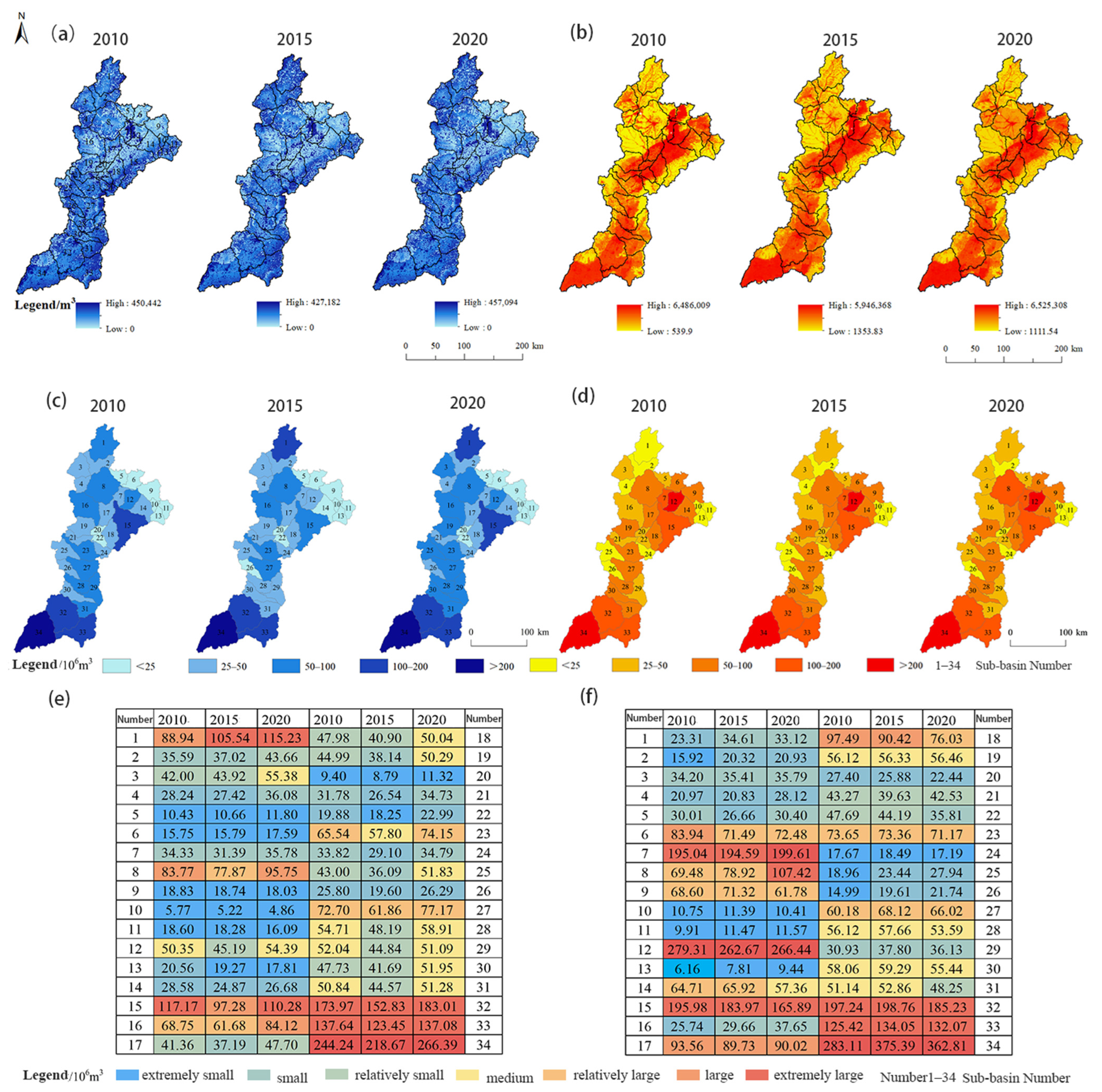
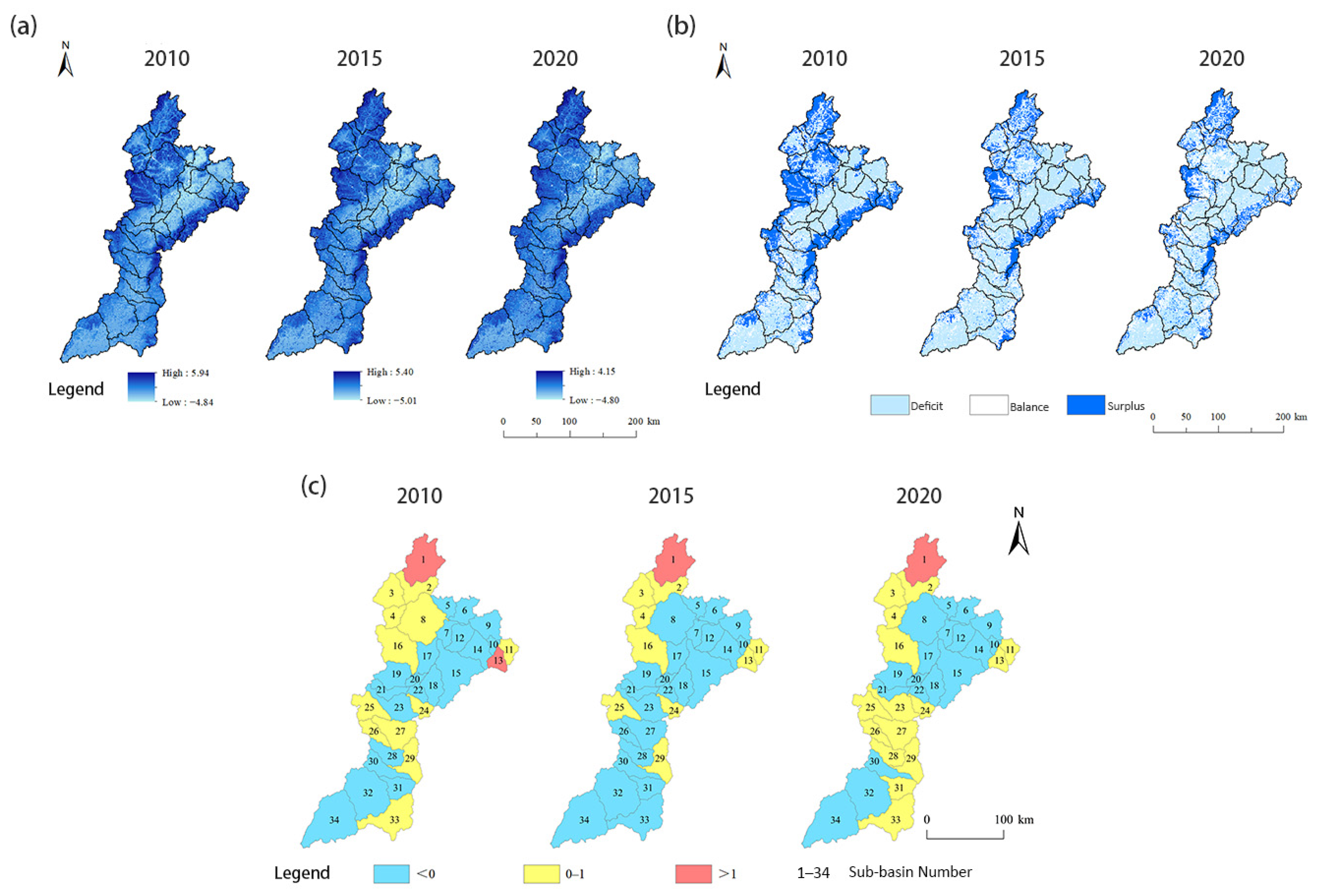

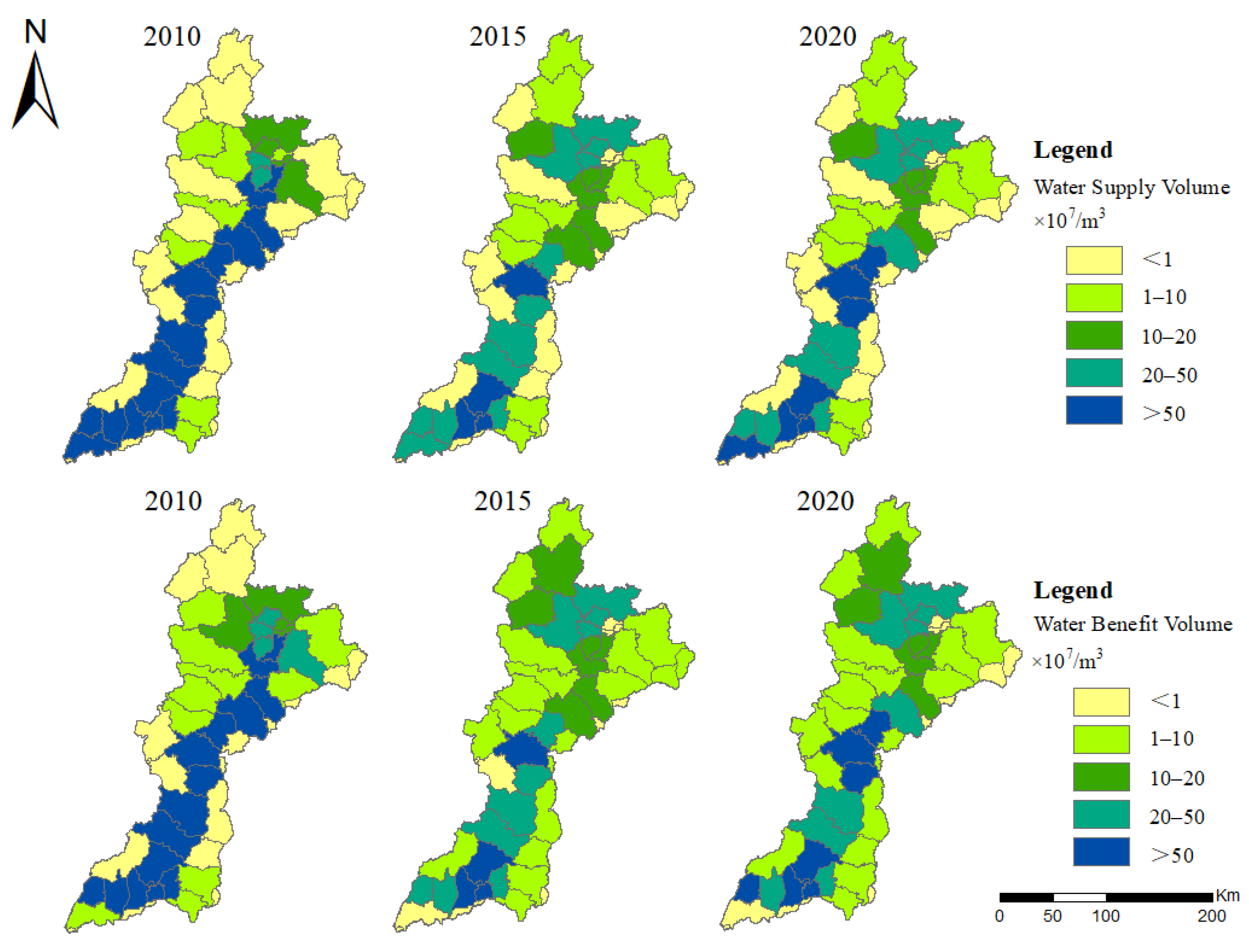
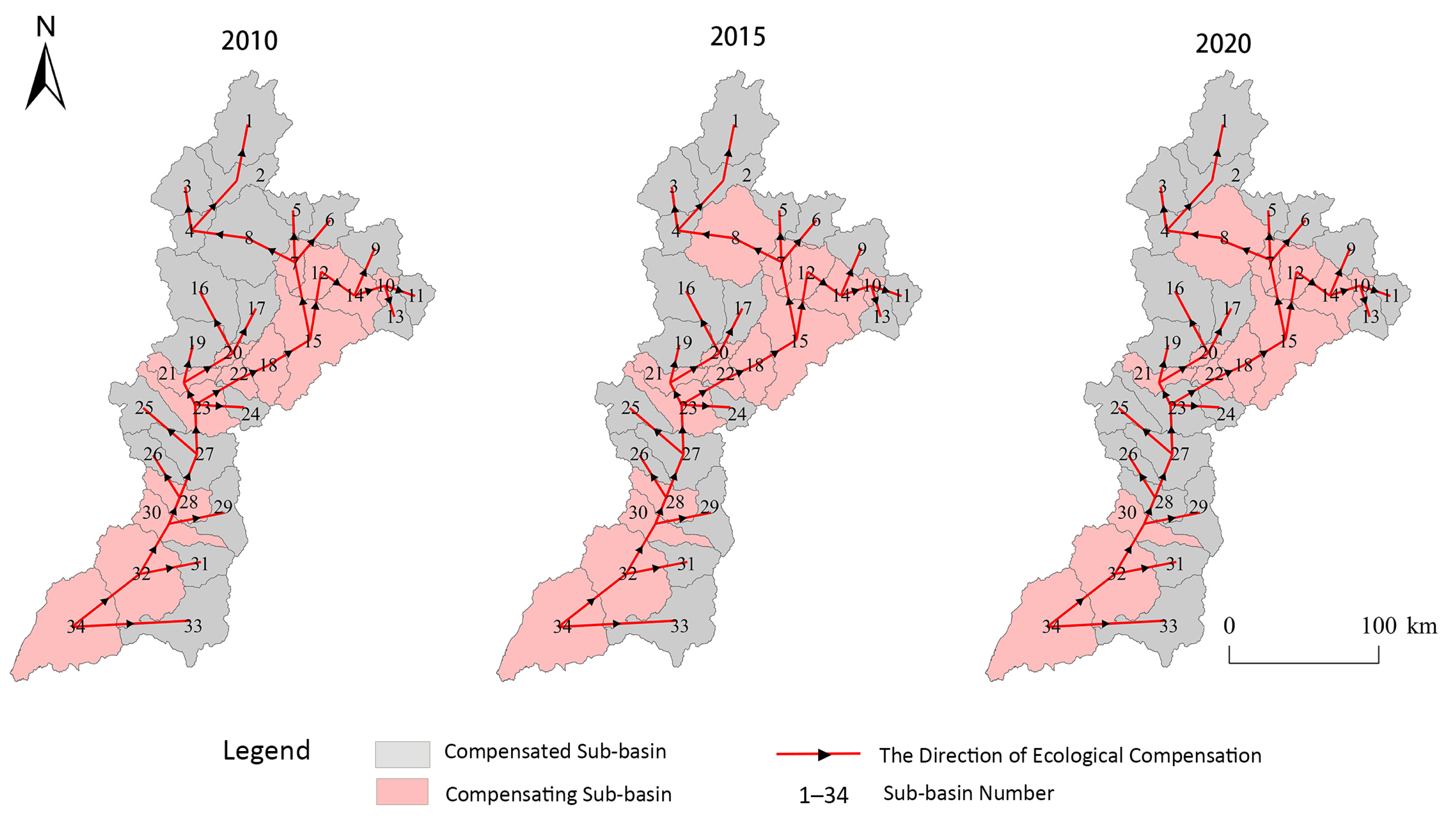
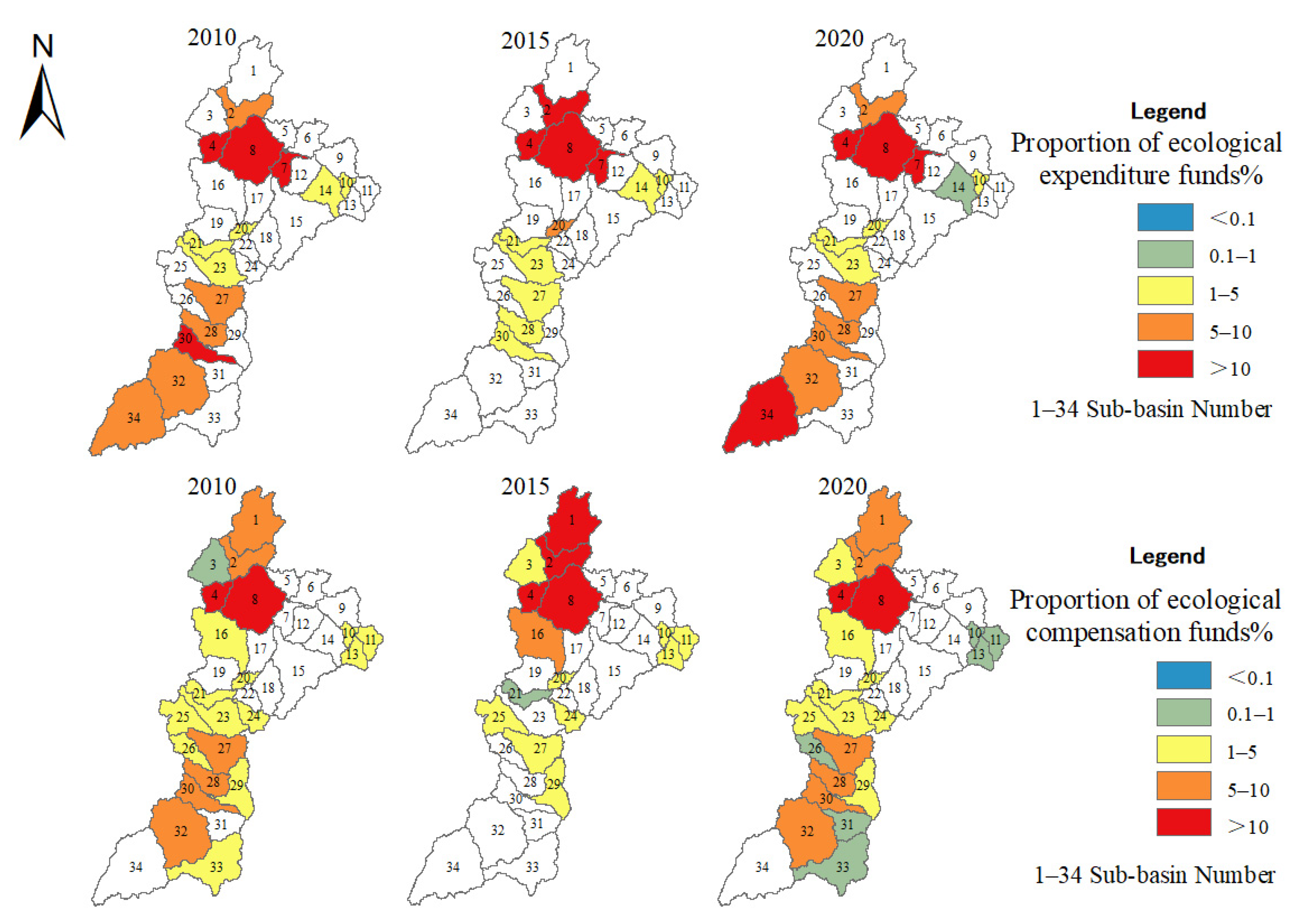
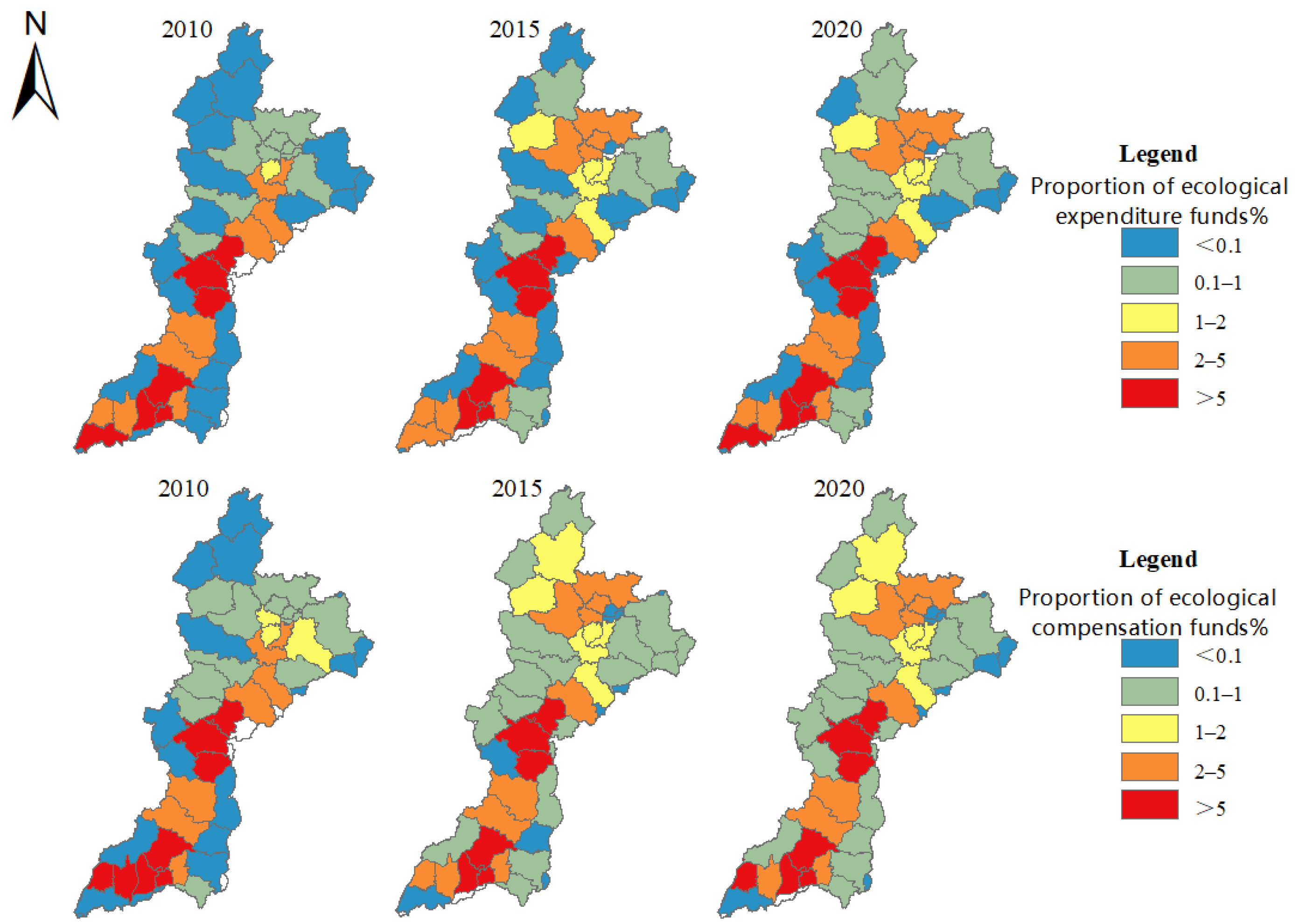
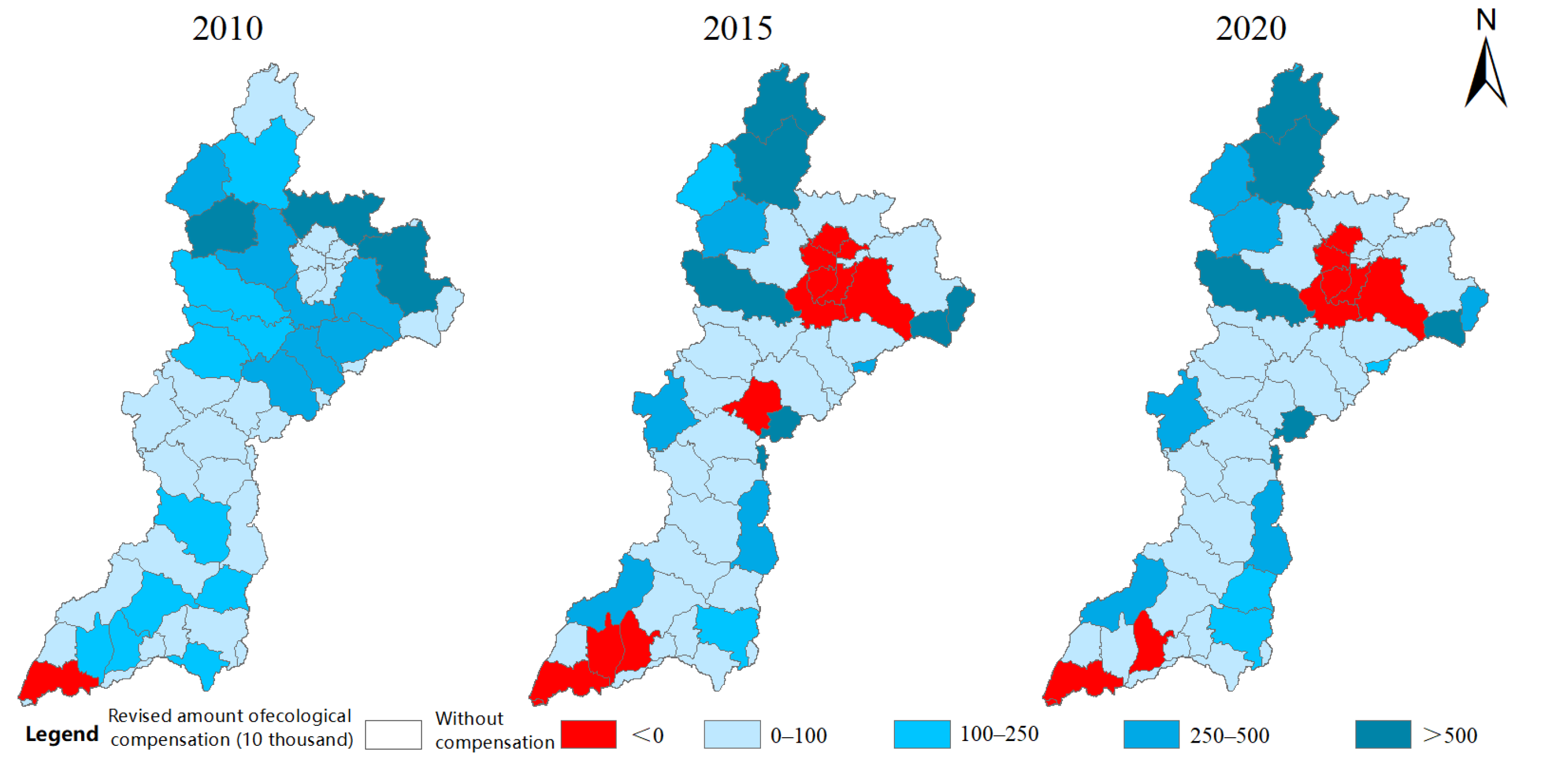
| Year | Supply Nodes | Demand Nodes | Edges with Active Flows | Edges Without Active Flows | Network Denstity |
|---|---|---|---|---|---|
| 2010 | 14 | 20 | 21 | 12 | 0.64 |
| 2015 | 10 | 24 | 15 | 18 | 0.45 |
| 2020 | 16 | 18 | 23 | 10 | 0.70 |
| The Proportion of Ecological Expenditure | The Proportion of Ecological Compensation Funds | |||||||
|---|---|---|---|---|---|---|---|---|
| Amount of Counties with the Value Greater than 5% | Amount of Counties with the Value Less than 0.1% | The Top Three Counties | The Counties with the Lowest Value | Amount of Counties with the Value Greater than 5% | Amount of Counties with the Value Less than 0.1% | The Top Three Counties | The Counties with the Lowest Value | |
| 2010 | 7 | 25 | Lingshi County 11.86% Xinjiang County 9.24% Houma City 9.12% | Qinshui County, Yushe County, Xi County, Shenchi County, Qinyuan County, Wuxiang County 0 | 8 | 22 | Lingshi County 11.91% Xinjiang County 9.37% Houma City 9.14% | Qinshui county, Shenchi County, Qinyuan County, Wuxiang County 0 |
| 2015 | 6 | 21 | Lingshi County 8.71%, Xinjiang County 8.36%, Houma City 8.25% | Yingze District, Wenxi county, 0 | 6 | 11 | Lingshi County 8.82%, Xinjiang County 8.34%, Houma City 8.32% | Linyi County, Wenxi County, 0 |
| 2020 | 6 | 20 | Xinjiang County 9.06%, Houma City 8.93%, Lingshi County 8.5% | Yingze District, Yu County, Wenxi County 0 | 7 | 13 | Xinjiang County 9.06%, Houma City 9.01%, Lingshi County 8.67% | Linyi County, Wenxi County, 0 |
Disclaimer/Publisher’s Note: The statements, opinions and data contained in all publications are solely those of the individual author(s) and contributor(s) and not of MDPI and/or the editor(s). MDPI and/or the editor(s) disclaim responsibility for any injury to people or property resulting from any ideas, methods, instructions or products referred to in the content. |
© 2025 by the authors. Licensee MDPI, Basel, Switzerland. This article is an open access article distributed under the terms and conditions of the Creative Commons Attribution (CC BY) license (https://creativecommons.org/licenses/by/4.0/).
Share and Cite
Duan, F.; Wen, S.; Fan, X.; Li, J.; Zhou, R.; Wu, J.; Dong, C. Simulation of Multi-Scale Water Supply Service Flow Pathways and Ecological Compensation for Urban–Rural Sustainability: A Case Study of the Fenhe River Basin. Land 2025, 14, 664. https://doi.org/10.3390/land14040664
Duan F, Wen S, Fan X, Li J, Zhou R, Wu J, Dong C. Simulation of Multi-Scale Water Supply Service Flow Pathways and Ecological Compensation for Urban–Rural Sustainability: A Case Study of the Fenhe River Basin. Land. 2025; 14(4):664. https://doi.org/10.3390/land14040664
Chicago/Turabian StyleDuan, Fei, Siyu Wen, Xuening Fan, Jiacheng Li, Ran Zhou, Jiansheng Wu, and Chengcheng Dong. 2025. "Simulation of Multi-Scale Water Supply Service Flow Pathways and Ecological Compensation for Urban–Rural Sustainability: A Case Study of the Fenhe River Basin" Land 14, no. 4: 664. https://doi.org/10.3390/land14040664
APA StyleDuan, F., Wen, S., Fan, X., Li, J., Zhou, R., Wu, J., & Dong, C. (2025). Simulation of Multi-Scale Water Supply Service Flow Pathways and Ecological Compensation for Urban–Rural Sustainability: A Case Study of the Fenhe River Basin. Land, 14(4), 664. https://doi.org/10.3390/land14040664




